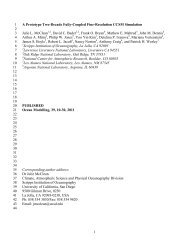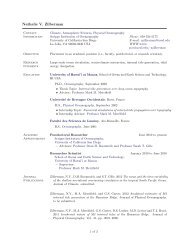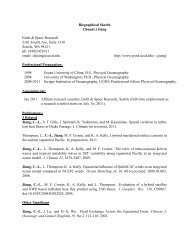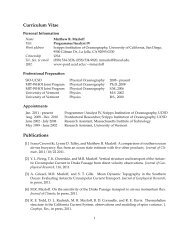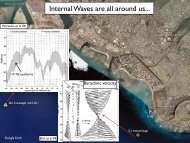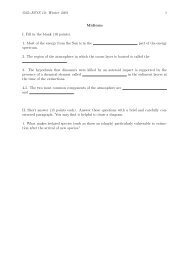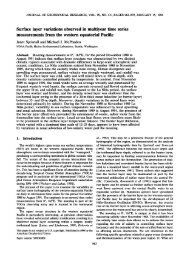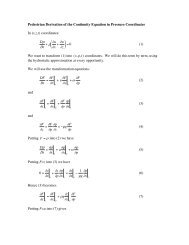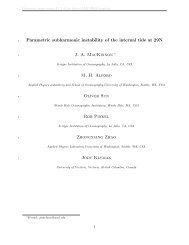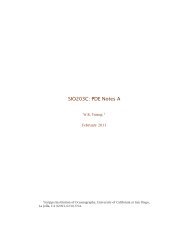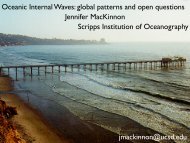NSF proposal - Physical Oceanography Research Division
NSF proposal - Physical Oceanography Research Division
NSF proposal - Physical Oceanography Research Division
You also want an ePaper? Increase the reach of your titles
YUMPU automatically turns print PDFs into web optimized ePapers that Google loves.
Project Summary<br />
Eddy diffusivities in the Southern Ocean from an eddying model<br />
Alexa Griesel, Sarah T. Gille, Julie L. McClean<br />
Summary. Realistic depiction of Southern Ocean eddy dynamics is critical in models<br />
used for climate prediction. Mixing generated by mesoscale eddies is believed to play<br />
an important role in the transfer of water masses and tracers across the Antarctic Circumpolar<br />
Current (ACC). In turn, these water mass transfers are thought to control the<br />
global overturning circulation and inter-ocean exchange. The central goals of this <strong>proposal</strong><br />
are to (1) quantify Lagrangian isopycnal eddy diffusivities in the Southern Ocean<br />
and to characterize their horizontal and vertical distributions, and (2) to assess their ability<br />
to parameterize isopycnal eddy tracer fluxes across the ACC. We will address these<br />
questions using the 0.1 ◦ , 42-level global configuration of the Los Alamos National Laboratory<br />
(LANL) Parallel Ocean Program (POP).<br />
Intellectual Merit. Large uncertainty exists in the representation of Southern Ocean eddy<br />
mixing processes in standard climate scale ocean models. The effects of eddies are commonly<br />
parameterized using eddy diffusion, and climate scale models are very sensitive to<br />
the magnitude of the eddy diffusion coefficients in the Southern Ocean. Whether the sensitivity<br />
of the ocean circulation to surface forcing is altered when using constant eddy diffusion<br />
coefficients rather than variable eddy diffusion coefficients remains unclear, and,<br />
more fundamentally, if local, or even zonally integrated tracer transports are simulated<br />
adequately by the eddy diffusion model. A related fundamental issue is to determine the<br />
horizontal and vertical distributions of the eddy diffusion coefficients. Different methods<br />
have resulted in conflicting magnitudes and spatial distributions in the Southern Ocean.<br />
Lagrangian floats provide a way to test the applicability of the diffusion model. We propose<br />
to deploy O(10,000) numerical floats in POP, at various locations within and outside<br />
the ACC and at a range of depth levels to estimate Lagrangian diffusivities and their spatial<br />
distributions. The skill of these Lagrangian diffusivities in parameterizing zonally<br />
integrated as well as local eddy tracer transport in the ACC will be assessed. This proposed<br />
work will contribute to ongoing efforts to reconcile conflicting diffusivity estimates<br />
for the Southern Ocean and will ultimately allow us to assess how much the spatial structure<br />
of the diffusivities matters in simulating Southern Ocean eddy fluxes accurately.<br />
.<br />
Broader Impacts. The proposed work will contribute to early career development of a<br />
postdoctoral researcher. The project will explore different ways to parameterize mixing<br />
coefficients, which will be testable in predictive climate models. A detailed assessment<br />
of Lagrangian methods and their relation to eddy fluxes and diffusivity estimates from<br />
other methods will benefit efforts to analyze data from floats deployed all over the ocean.<br />
In particular, the methods investigated in this study will contribute to the interpretation<br />
of in situ data returned by the 180 RAFOS floats that are being deployed as part of the<br />
Diapycnal and Isopycnal Mixing Experiment in the Southern Ocean (DIMES).<br />
B–1
Results from Prior <strong>NSF</strong> Support<br />
A. Griesel: no prior <strong>NSF</strong> support.<br />
S.T. Gille: Collaborative <strong>Research</strong>: DIMES, Diapycnal and Isopycnal Mixing in the<br />
Southern Ocean. OCE-0622740 (Sarah Gille); 7/1/07-6/30/12, $555,192. DIMES is a<br />
UK/US effort to measure diapycnal mixing processes and along-isopycnal stirring along<br />
the steeply tilted isopycnals of the Southern Ocean. Fieldwork successfully began in January<br />
2009. Gille et al. (2007) summarize the DIMES objectives. At Scripps, preliminary<br />
work in preparation for the field measurements has focused on analysis of Lagrangian<br />
floats released in the Parallel Ocean Program (Griesel et al., 009a,b). We have also carried<br />
out work to evaluate the vertical resolution of XCTD data (Gille et al., 2009).<br />
J. McClean: Title: Mesoscale Variability and Processes in an Eddy-Resolving Global<br />
POP Simulation. OCE-0221781/0549225: 09/01/2002-08/31/2008, $391,168. The mean<br />
and variability of the upper ocean circulation of global 0.1 ◦ POP was compared with data<br />
from altimetry, current meters, time series of temperature profiles, and published results<br />
of volume transports and meridional heat transports (Maltrud and McClean, 2005; Mc-<br />
Clean et al., 2006, 2008). A 0.1 ◦ North Atlantic configuration of POP was compared with<br />
tide gauges and altimetry using wavelet transforms (Tokmakian and McClean, 2003).<br />
Interannual processes in the Indo-Pacific as depicted by POP were examined (McClean<br />
et al., 2005; Prasad and McClean, 2004). Studies of mesoscale properties were conducted<br />
in the Agulhas Retroflection (Byrne and McClean, 2008) and off Japan in the Kuroshio<br />
Extension System Study (KESS) data collection region (Rainville et al., 2007). Model eddy<br />
heat fluxes and the appropriateness of diffusive parameterizations were examined in the<br />
Southern Ocean (Griesel et al., 009a,b). Model output was disseminated broadly throughout<br />
the oceanographic community.<br />
PROJECT DESCRIPTION<br />
1 Introduction<br />
Eddy mixing plays a unique role in the horizontal and vertical transfer of tracers across<br />
the Antarctic Circumpolar Current (ACC), and it is thought to control the global circulation<br />
of heat, carbon and other climatically important tracers through its impact on<br />
overturning rate and inter-ocean exchanges (Johnson and Bryden, 1989; Marshall et al.,<br />
1993; Döös and Webb, 1994; Speer et al., 2000; Bryden and Cunningham, 2003; Marshall<br />
and Radko, 2003). The Southern Ocean has undergone significant climate change (Gille,<br />
2002, 2008; Böning et al., 2008), and eddy fluxes may significantly contribute to the observed<br />
warming in the Southern Ocean (e.g. Hogg et al., 2008). The classical paradigm<br />
of the zonal mean circulation in the Southern Ocean is one where wind driven Ekman<br />
transport that tends to steepen isopycnals is approximately balanced by an eddy-driven<br />
circulation that tends to flatten isopycnals. This leads to a residual circulation that governs<br />
net exchange of tracers (Karsten et al., 2002; Karsten and Marshall, 2002; Marshall<br />
and Radko, 2003). However, the degree of cancellation is unclear and large zonal varia-<br />
D–1
tions in residual circulation may exist (Treguier et al., 2007). The characterizaton of the<br />
three-dimensional distribution of eddy-driven mixing in the ACC is therefore crucial and<br />
remains highly uncertain.<br />
Numerical models typically represent eddy-driven mixing as a downgradient transfer<br />
along isopycnals at a rate proportional to a diffusivity coefficient (Gent and McWilliams,<br />
1990; Griffies, 1998). Coarse resolution models are very sensitive to the magnitude, and<br />
the horizontal and vertical distributions of the eddy mixing coefficients (Kamenkovich<br />
and Sarachik, 2004; Griesel and Morales Maqueda, 2006; Danabasoglu and Marshall,<br />
2007). Moreover, the transient behavior of a model with explicit eddies can be quite different<br />
from the behavior of one in which eddy effects are parameterized with a constant<br />
diffusivity (Hallberg and Gnanadesikan, 2006).<br />
Two fundamental questions drive the work proposed here:<br />
(1) Can eddy diffusion provide an appropriate parameterization of eddy fluxes?<br />
(2) What are the magnitudes and spatial distributions of the diffusion coefficients?<br />
We propose to address these questions in the framework of the 0.1 ◦ , 42-level global configuration<br />
of the Los Alamos National Laboratory (LANL) Parallel Ocean Program (POP)<br />
(Maltrud et al., 2008). We plan to evaluate how well eddy parameterizations can emulate<br />
the complex spatio-temporal effects of eddies in the Southern Ocean of POP by<br />
diagnosing Eulerian eddy tracer fluxes and their relation to Eulerian mean gradients, and<br />
also by means of Lagrangian statistics. To examine Lagrangian statistics, we will deploy<br />
O(10,000) numerical floats at locations both inside and outside the ACC and at a range of<br />
depth levels.<br />
Lagrangian floats provide a way to test the applicability of the eddy diffusion model<br />
(see LaCasce, 2008, for an overview). Taylor (1921) showed that Lagrangian particles<br />
in isotropic and homogeneous turbulence spread diffusively, with a constant diffusivity<br />
calculated from the integral of the velocity autocorrelation. Davis (1987, 1991) refined<br />
the theoretical framework to allow both the mean flow and the diffusivity to be spatially<br />
variable, and to allow the theory to be applied to ocean float data. Preliminary results<br />
with a limited number of floats in the POP model suggest that, under certain conditions,<br />
a diffusive limit can be reached in the ACC, providing a basis for the proposed work<br />
(Griesel et al., 009b). Only a few investigations have studied Lagrangian statistics in the<br />
ACC (e.g. Sallée et al., 2008), and of the work we have seen, only our own preliminary<br />
study (Griesel et al., 009b) has studied their depth dependence, albeit with limited spatial<br />
resolution. Davis (1987, 1991) theorized on the mechanisms by which the Lagrangian<br />
single-particle statistics are related to Eulerian eddy tracer fluxes through an elaboration<br />
of the familiar eddy diffusion model in an eddy field with finite scales. No previous study<br />
that we have identified has investigated in detail the extent to which Lagrangian statistics<br />
are consistent with Davis (1987, 1991)’s model in terms of emulating the Eulerian eddy<br />
fluxes in a realistic configuration of the Southern Ocean.<br />
D–2
Figure 1: Vertical profiles of eddy<br />
kinetic energy ( 1 2 (u′2 + v ′2 )) for<br />
AUSSAF data compared with profiles<br />
from other sites in the ACC:<br />
southeast of New Zealand and<br />
Drake Passage (solid lines) and<br />
from western boundary current<br />
systems: Agulhas, Gulf Stream<br />
and Kuroshio Extension (dashed<br />
lines), from Phillips and Rintoul<br />
(2000).<br />
2 Spatial distribution of eddy mixing in the Southern Ocean<br />
In the absence of direct measurements of eddy mixing across the ACC, a number of studies<br />
have attempted to deduce horizontal and vertical distributions of eddy diffusivities.<br />
These studies have produced conflicting results, although, as we will explain below, they<br />
are consistent with different hypotheses for eddy diffusivity distributions. On the one<br />
hand, eddy diffusivities are hypothesized to be determined by eddy kinetic energy (EKE)<br />
(e.g. Keffer and Holloway, 1988; Stammer, 1998). A recent study found variations in eddy<br />
stirring and mixing rates using finite-time Lyapunov exponents to be closely related to<br />
variations in mesoscale activity, or √ EKE (Waugh and Abraham, 2008). Diffusivities inferred<br />
from Lagrangian floats are also often highly correlated with eddy kinetic energy<br />
(Krauss and Böning, 1987; Lumpkin et al., 2001; Zhurbas and Oh, 2003; Sallée et al., 2008),<br />
resulting in local maxima of eddy diffusivity in the core of the ACC (Sallée et al., 2008).<br />
On the other hand, strong currents can also act as mixing barriers (e.g. Bower et al., 1985),<br />
leading to small effective eddy diffusivities in the core of the ACC (e.g. Marshall et al.,<br />
2006; Naveira Garabato et al., 2009). Naveira Garabato et al. (2009) employed mixing<br />
length arguments, and found that it is the spatial distribution of the eddy length scales,<br />
rather than the eddy velocities or EKE that determines the spatial distributions of the<br />
eddy diffusivities. At any given geographic location, the magnitude of the diffusivity<br />
depends on the relative importance of the strength of the mean flow and EKE respectively<br />
(Shuckburgh et al., 2008a,b). Griesel et al. (009b) reconciled some of the conflicting<br />
horizontal near-surface eddy diffusivity distributions by pointing out that dominant correlations<br />
of Lagrangian diffusivities with EKE may have been related to not using long<br />
enough time lags in the integral of the Lagrangian velocity autocovariance. However, the<br />
float deployments used by Griesel et al. (009b) were limited, both in number and spatial<br />
distribution, and did not resolve the ACC and the region north of the ACC sufficiently to<br />
D–3
Figure 2: Depth dependence of alongstreamline<br />
averaged effective eddy diffusivities,<br />
estimated from tracers advected with<br />
the velocity of the Southern Ocean State<br />
estimate (SOSE) from Abernathy et al.<br />
(2008).<br />
distinguish regimes with strong and weak mean flow.<br />
There is also a lack of consensus on the depth dependence of the eddy diffusivities.<br />
Diffusivities are predicted to decrease with depth when the depth dependence is dominated<br />
by the decrease of eddy velocity or EKE with depth (see Figure 1). Such a decrease<br />
has been found by Ferreira et al. (2005); Eden (2006); Olbers and Visbeck (2005)<br />
and Griesel et al. (009a). Conversely, critical layer theory predicts that the diffusivity<br />
should have a maximum at the depth where the speed of the mean flow is comparable<br />
to the phase speed of Rossby waves (Green, 1970; Smith and Marshall, 2009). Indeed,<br />
enhanced diffusivities at depth have been diagnosed in eddying models of varying complexity<br />
by Cerovecki et al. (2009); Smith and Marshall (2009) and Abernathy et al. (2008)<br />
(see Figure 2), using the Nakamura (1996) method, and from flux/gradient relationships<br />
(Treguier, 1999; Smith and Marshall, 2009). Of the studies listed here, only our investigation<br />
(Griesel et al., 009b) used Lagrangian methods to investigate depth dependence. We<br />
found that depth invariant Lagrangian diffusivity in the core of the ACC jet arose from a<br />
combination of eddy velocities decreasing and Lagrangian eddy length scales increasing<br />
with depth.<br />
Even though eddy mixing can be diagnosed with different methods, the fundamental<br />
issue remains whether these eddy diffusion coefficients actually have sufficient skill to parameterize<br />
eddy transports in a downgradient parameterization. Challenges arise when<br />
attempting to correlate downgradient parameterizations with the eddy fluxes. One reason<br />
for low correlations of the eddy fluxes with their parameterizations and for unphysically<br />
large positive and negative values of the diffusivities is the presence of strong rotational<br />
components (Lau and Wallace, 1979; Marshall and Shutts, 1981, henceforth MS81).<br />
These rotational components of the eddy flux do not contribute to the local heat budget,<br />
since they transport as much heat into a region as out of it (Jayne and Marotzke, 2002).<br />
In previous work with POP Griesel et al. (009a) showed that the rotational component of<br />
the eddy heat flux dominates over all spatial scales. We also pointed out the challenges<br />
of finding eddy diffusion coefficients that are physically meaningful, smoothly varying<br />
and most importantly, that still capture most of the eddy flux in a downgradient parameterization.<br />
On the other hand, Griesel et al. (009b) have shown that the diffusive limit<br />
can be reached over lengthscales of 10 ◦ longitude with Lagrangian floats. One aim of<br />
D–4
the proposed work is to reconcile these two findings. Significantly more numerical float<br />
deployments than the O(100) deployments used in Griesel et al. (009b) are needed in order<br />
to sufficiently resolve spatial variability of Lagrangian diffusivities. Since Lagrangian<br />
floats are widely used and are an invaluable tool to assess eddy mixing from observations,<br />
it is important to be able to reconcile the previously reported estimates of eddy<br />
diffusivities that used different methods, as well as compare the Eulerian analysis with<br />
the Lagrangian eddy statistics. This will allow better interpretation of Lagrangian data<br />
that emerge from field programs.<br />
The Diapycnal and Isopycnal Mixing Experiment in the Southern Ocean (DIMES) will<br />
deploy a total of 180 RAFOS floats into the Southern Ocean. While DIMES will deliver a<br />
wealth of data on eddy mixing in the Southern Ocean, it is crucial to be able to interprete<br />
these properly. It is not feasible to deploy O(10,000) in the real ocean, and we will be able<br />
to develop the strategies for achieving robust results with the more limited data from the<br />
observational program.<br />
3 Objectives<br />
The first overarching goal of the proposed work is to characterize magnitudes and horizontal<br />
and vertical distributions of the Lagrangian eddy diffusivities in the Southern<br />
Ocean and to evaluate whether these can be reconciled with existing hypotheses. The<br />
hypotheses are that eddy diffusivities are to first order related to the spatial distributions<br />
of eddy kinetic energy, which would result in diffusivities being elevated at the surface<br />
and decreasing with depth in the core of the ACC. The alternative hypothesis is that eddy<br />
mixing is to first order determined by the relative strength of the mean flow and phase<br />
speed of Rossby waves, leading to the ACC jet acting as a mixing barrier at the surface,<br />
and diffusivities increasing in the core of the ACC jet.<br />
The second overarching goal is to investigate how well these diffusivities parameterize<br />
the integrated and local eddy tracer transports across the ACC. We propose to<br />
deploy a large number of numerical floats (O(10,000)) in POP, to quantify Lagrangian<br />
diffusivities and their spatial distributions, and to evaluate the relation of Eulerian eddy<br />
tracer fluxes and mean tracer gradients to assess the hypothesis that Lagrangian floats<br />
can be used to quantify eddy mixing and its spatial variation in the Southern Ocean.<br />
4 Approach and Methodology<br />
4.1 Objective 1: Characterizing the effects of eddies as a diffusive process<br />
using Lagrangian statistics<br />
4.1.1 Background<br />
Davis (1991) showed that the evolution of the mean tracer concentration in inhomogeneous<br />
flows with finite scale eddies depends only on the initial condition of the mean<br />
and source fields and the single particle statistics. The single particle Lagrangian diffu-<br />
D–5
sivity as a function of time lag is related to the Eulerian eddy fluxes and mean tracer<br />
gradients through the elaborated flux versus gradient law,<br />
〈u ′ i (x, t)Θ′ (x, t)〉 = lim τ−→∞ −<br />
∫ t<br />
0<br />
dτ∂ τ κ ij (x, τ)∂ xj Θ(x, t − τ) (1)<br />
Equation (1) specifies the flux of a (passive) tracer from the recent history of its mean<br />
concentration. The driving force for the eddy flux at time t is the sum of previous Θ gradients<br />
at times t − τ, weighted by the time derivative of κ at time range τ. κ will be defined<br />
below. This is an elaboration of the familiar advection-diffusion equation, where the elaboration<br />
reflects the finite scales of the eddies. If τ goes to infinity, or rather, is greater than<br />
some time T, that reflects the finite scales of the dispersing eddies, κ(x, t) approaches a<br />
constant value κ ∞ and the eddy flux is approximated by the typical advection-diffusion<br />
equation,<br />
〈u ′ i (x, t)Θ′ (x, t)〉 = −κ ∞ ij (x)∂ x j<br />
Θ(x, t) (2)<br />
The diffusivity κ ∞ is determined by the integral of the Lagrangian autocovariance<br />
function:<br />
κ ij (x, τ) =<br />
∫ 0<br />
−τ<br />
d ˜τ〈u ′ i (t 0|x, t 0 ) u ′ j (t 0 + ˜τ|x, t 0 )〉 L , (3)<br />
κ ∞ ij = lim τ−→∞ κ ij (x, τ), (4)<br />
where u ′ i (t 0 + τ|x, t 0 ) denotes the residual velocity of a particle at time t 0 + τ passing<br />
through x at time t 0 . For stationary and homogeneous statistics, the diffusivity is equal to<br />
half the time rate of change of the dispersion 〈d ′2 〉<br />
κ ij (x, τ) = 1 2 d t〈d ′ i (τ|x, t 0)d ′ j (τ|x, t 0)〉 L , (5)<br />
where d ′ (τ|x, t 0 ) is the displacement at time τ from its starting position, with the mean<br />
displacement removed. There are a number of challenges when computing Lagrangian<br />
diffusivities from eddying models, or oceanic data. To isolate the eddy velocities from the<br />
float velocities, a mean needs to be subtracted. As Figure 3a shows, the time-averaged Eulerian<br />
mean velocities are highly inhomogeneous in space. As shown by Oh et al. (2000),<br />
in a shear flow the along-stream diffusivity is affected by the shear dispersion. Therefore,<br />
if we remove a spatially-uniform average from each float velocity, we are left with a residual<br />
due to the mean shear that will imply dispersion and may dominate the diffusivity<br />
estimate (Bauer et al., 1998). Griesel et al. (009b) achieved good convergence properties<br />
of the Lagrangian diffusivities when they subtracted this Eulerian mean, thereby minimizing<br />
the influence of shear dispersion (Figure 3b,c). In an ocean with inhomogeneous,<br />
strong mean flows and with an eddy field of varying horizontal scale, the challenge is to<br />
find the asymptotic behavior of the velocity autocorrelation, which requires sufficiently<br />
long time lags (e.g. Bauer et al., 1998; Veneziani et al., 2004; Davis, 2005). The challenge<br />
arises because of the presence of strong rotational components in the eddy field, showing<br />
up in vortices or meanders of the Lagrangian trajectories that lead to oscillations in the autocovariances<br />
(Figure 4) as discussed by Berloff and McWilliams (2002a,b) and Veneziani<br />
D–6
a)<br />
⊥ dispersion (km 2 )<br />
2 x 1011<br />
b) ⊥ 300m<br />
1<br />
0<br />
0 250 500 750 1000<br />
time lag (days)<br />
|| dispersion (km 2 )<br />
3 x 1012 c) || 300m<br />
2<br />
1<br />
0<br />
0 250 500 750 1000<br />
time lag (days)<br />
Figure 3: a) Trajectories of 160 floats deployed at a depth of 300 m around latitude 60 ◦ S and<br />
longitude 180 ◦ W in one-quarter degree initial spacing from Griesel et al. (009b) after they have<br />
travelled for 1045 days (about 3 years). In color is the magnitude of the Eulerian 1998-1999 mean<br />
velocity interpolated to each float point. Lower panels show the corresponding long-time (1045<br />
days) mean square displacement for these trajectories in the cross-stream (b) and along-stream<br />
directions (c). The dispersion was calculated after subtraction of the spatially highly non-uniform<br />
Eulerian mean velocity in (a) from every float velocity. Shaded are 2*standard deviations from<br />
bootstrapping by subsampling the floats for each deployment with replacement. The dispersion<br />
is well approximated by the constant diffusivity at a time lag of 100 days (solid lines in a and b,<br />
where the dashed lines are the 95% confidence intervals).<br />
et al. (2005). Questions remain as to whether this is a transient behavior, or whether the<br />
diffusive limit can still be reached after long enough times lags (see Figure 3b,c), as suggested<br />
by Griesel et al. (009b).<br />
The Lagrangian diffusivity of Taylor can be expressed as the product of the eddy kinetic<br />
energy and an eddy decorrelation time scale T e , or, alternatively, with an eddy length<br />
scale L e = √ (EKE)T e . This eddy length scale can be interpreted as the mean displacement<br />
induced by an eddy. It is unclear how this eddy length scale is related to the typical<br />
eddy mixing length of for example Armi and Stommel (1983). Ferrari and Nikurashin<br />
(2009) and Naveira Garabato et al. (2009) hypothesize that the true mixing length of eddies<br />
is proportional to the Lagrangian eddy length scale divided by 1 + (U m − c) 2 , where<br />
U m is the strength of the mean flow and c is the phase speed of Rossby waves. In that<br />
sense, mixing length itself is dependent on eddy kinetic energy, and the eddy mixing<br />
length equals the Taylor eddy length scale, but reduced by the strength of the mean flow.<br />
This is in contrast to the assumption that in the presence of a mean flow the Taylor diffusivity<br />
by itself, as refined by Davis (1987, 1991), is able to quantify eddy mixing.<br />
D–7
cross−stream direction<br />
latitude<br />
300<br />
200<br />
100<br />
0<br />
−100<br />
−52<br />
−54<br />
−56<br />
−58<br />
−60<br />
along−stream direction<br />
−62<br />
180 190 200 210 220<br />
longitude<br />
3000<br />
a) b)<br />
c)<br />
κ m 2 s −1 )<br />
κ (m 2 s −1 )<br />
2000<br />
1000<br />
0<br />
−1000<br />
3000<br />
2000<br />
1000<br />
10 20 30<br />
tlag (days)<br />
d)<br />
0<br />
0 20 40 60 80<br />
tlag (days)<br />
Figure 4: Circling and meandering trajectories<br />
(a) do not lead to any net cross-stream<br />
dispersion and the diffusivity as a function<br />
of time lag oscillates before it converges to<br />
the correct value of zero diffusivity (b). Real<br />
POP trajectories from Griesel et al. (009b) (c)<br />
show this oscillating behavior (d). Enough<br />
float trajectories such that the oscillations<br />
may cancel each other are needed as well as<br />
a long enough time lag to reach κ ∞<br />
4.1.2 Float Deployments in POP<br />
The Los Alamos National Laboratory (LANL) Parallel Ocean Program (POP) has been<br />
configured on a 0.1 ◦ , 42-level global tripole grid, which is Mercator south of 28.5 ◦ N (Maltrud<br />
et al., 2008). The POP model has one of the highest horizontal resolutions used<br />
in global ocean modeling applications, leading to horizontal resolutions between 4 and<br />
9 km for the Southern Ocean. POP is eddy resolving in the sense that between about<br />
50 ◦ S and 50 ◦ N it resolves the first baroclinic Rossby radius, which is smaller than typical<br />
eddy length scales (Smith et al., 2000). To date the simulation has been run for 100 years<br />
and is forced with the monthly normal year atmospheric fluxes constructed by Large and<br />
Yeager (2004) for the Common Ocean-Ice Reference Experiments (CORE). Normal year<br />
forcing consists of single annual cycles of all atmospheric data needed to force an ocean<br />
model and is representative of climatological conditions over 43 years of interannually<br />
varying atmospheric state. It has been constructed to retain synoptic variability (i.e. atmospheric<br />
storms) with a seamless transition from 31 December to 1 January (Large and<br />
Yeager, 2004). The forcing uses the National Center for Environmental Prediction/ National<br />
Center for Atmospheric <strong>Research</strong> (NCEP/NCAR) reanalysis corrected with scatterometer<br />
data. A marked improvement was seen in the pathways of the Agulhas eddies,<br />
relative to the global 0.1 ◦ , 40-level standard z-level dipole simulation of Maltrud and Mc-<br />
Clean (2005). Here we propose to conduct a 5-10 year global tripole 0.1 ◦ POP simulation<br />
forced with interannually-varying synoptic CORE forcing for the more recent years 1997-<br />
2007 initialized from this spun-up ocean state. The exact duration of the run will depend<br />
on the throughput of the <strong>NSF</strong> Terascale high performance computing platforms available<br />
to us. We will, however, be able to archive 2-3 years of daily state variables and flux terms,<br />
and otherwise monthly means.<br />
To analyze Lagrangian motions, it is crucial that we are able to advect the POP floats<br />
as part of the model runs, using the time-varying three-dimensional velocity field. The<br />
position of the floats will be evaluated with a fourth-order Runge Kutta scheme at every<br />
model time step of 6 minutes. This is clearly an advantage over previous studies that<br />
used multiple-day averages of velocities to advect floats. As shown by (Griesel et al.,<br />
D–8
009b), floats advected by the three-dimensional model field stay on isopycnal surfaces<br />
reasonably well, at least away from the oceanic surface and mixed layers. However, small<br />
deviations from isopycnals are evidence of small diapycnal mixing rates that can be crucial<br />
for Southern Ocean dynamics. Since there is great interest in understanding how<br />
three-dimensional motions may differ from isopycnal motions, we will also explore ways<br />
to correct the motion of the floats to force them to stay on an isopycnal. Additionally,<br />
there is the potential to investigate sensitivities of float trajectories to different advection<br />
schemes as well as model parameters.<br />
We propose to deploy a total of O(10,000) numerical floats in the following ways:<br />
(1) The depth dependence and horizontal variability of Lagrangian diffusivities has been<br />
investigated by Griesel et al. (009b), but spatial coverage of the floats was limited to the<br />
area within the ACC, and due to the limited number of floats, bins with significant realizations<br />
were sparse. To improve upon the numerical float deployments in POP, to<br />
achieve more spatial coverage within the ACC and also to cover the area north of the<br />
ACC, we propose to deploy floats at 4 different longitudes with a quarter degree initial<br />
spacing, and at latitudes corresponding to south of the Polar Frontal Zone, between the<br />
Polar Frontal Zone and Subantractic Front, and north of the Subantarctic Front. ”Point”<br />
deployments in this way will make it possible to track the spreading of a group of floats<br />
along one specific isopycnal interval. The mean position of the fronts will be estimated<br />
with time mean barotropic streamlines from the model. To sample with depth, the floats<br />
will be deployed at 4 different depth levels.<br />
(2) One deployment will be configured to match that of the DIMES experimental deployment<br />
scheme (around 105 ◦ W, 55 ◦ -60 ◦ S, and at two different depth levels, or isopycnal<br />
surfaces), to determine how well the limited number of floats deployed as part of DIMES<br />
can reproduce the magnitude and spatial variability of the extended deployments, and to<br />
help improve analysis methods for the real floats.<br />
(3) To assess sampling biases we will deploy the same number of floats as in (1) but distributed<br />
horizontally and vertically uniformly over the whole Southern Ocean. One of the<br />
main questions is whether Lagrangian statistics provide sufficient information to quantify<br />
possible mixing barriers at fronts, and whether Lagrangian statistics will be similar<br />
in this respect with uniform deployment as compared to when patches of floats are deployed<br />
in between the fronts as in (1) and (2). We will also address the question whether<br />
analysis in isopycnal space leads to similar conclusions compared to a situation in which<br />
the spreading of the floats is quantified with respect to depth interval.<br />
4.1.3 Analysis<br />
The goal of the proposed work is to infer robust Lagrangian diffusivities and spatial variation.<br />
We will use analysis scripts developed by Griesel et al. (009b) who have undertaken<br />
detailed sensitivity analysis. We will address the following questions:<br />
D–9
What are the characteristics of the Lagrangian trajectories in the Southern Ocean of<br />
POP relative to the mean streamlines? Bower and Rossby (1989) found that floats left<br />
the Gulf Stream much earlier at a depth of about 1000 m than closer to the surface, which<br />
could be an indication of enhanced eddy mixing at depth in the core of the Gulf Stream<br />
(see also Bower et al., 1985). However, deep floats were associated with little change<br />
in potential vorticity (PV) along their tracks, and therefore deep cross-stream exchange<br />
was not associated with cross-PV exchange (Bower, 1993). Several studies have examined<br />
mechanisms to explain how cross-stream exchange of fluid parcels is related to the<br />
occurence of meanders in jets (e.g. Bower, 1991; Dutkiewicz et al., 1993; Dutkiewicz and<br />
Paldor, 1994). Since we will archive the four-dimensional Eulerian POP fields, we will<br />
evaluate how cross-frontal exchanges are related to the meander time and space scale, to<br />
the definition of mean streamlines, and to the PV gradients. We will examine the individual<br />
pathways of the floats, and assess how quickly and where floats escape from the ACC<br />
and cross the Subantarctic Front. We will evaluate the length of time that floats remain<br />
within certain dynamical regimes, characterized for example by pressure or speed. These<br />
analyses will provide insights into where property exchanges occur and provide a basis<br />
for the following Lagrangian diffusivity and dispersion evaluation.<br />
Why and when is the diffusive limit reached? Our previous POP float results in the<br />
ACC have demonstrated the need to subtract spatially varying mean flows and the use<br />
of long enough time lags in the integral of the velocity autocovariance (Griesel et al.,<br />
009b). One hypothesis is that with a large enough number of floats the oscillations in<br />
the diffusivity as a function of time lag (Figure 4) arising from rotational components<br />
will cancel each other, and the correct diffusive limit can be reached. On the other hand<br />
Griesel et al. (009a) have concluded that in the case of the Eulerian eddy heat fluxes, the<br />
rotational component is not reduced even if the fluxes are averaged over scales much<br />
larger than the eddy scales. The analysis of Griesel et al. (009b) also showed that upper<br />
ocean trajectories showed more meandering and looping behavior than trajectories from<br />
deeper isopycnal layers. This might be an indication of floats getting locked in with the<br />
mean flow meanders in the upper ocean leading to reduced eddy length scales. We will<br />
analyze in detail the sensitivities of κ ∞ from equation (4) to the definition of mean streamlines,<br />
the subtraction of different means, the number of floats used, the length of the time<br />
lag, and bin sizes. We will evaluate the number of looping and non-looping trajectories<br />
for different depth levels and within and outside the ACC and whether the diffusivity<br />
converges to the same limit if more and more trajectories are used. We will concentrate<br />
on the symmetric components of the diffusivity tensor from equation (4) that represent<br />
irreversible mixing processes but will also compare them to the antisymmetric parts.<br />
What are the robust horizontal and vertical distributions of the Lagrangian eddy diffusivities?<br />
With the proposed POP float deployments we will be able to sample regions<br />
both north and south of the Subantarctic Front. We will investigate the hypothesis that<br />
eddy mixing is suppressed in the core of the ACC whereas it is not supressed in areas<br />
where the strength of the mean flow is comparable to the phase speed of Rossby waves.<br />
Results will be compared to recent estimates from Marshall et al. (2006); Abernathy et al.<br />
(2008) and Naveira Garabato et al. (2009) who use different measures for the effective dif-<br />
D–10
Figure 5: Eddy temperature fluxes v ′ T ′ (a), mean temperature<br />
)<br />
gradients ∂ y T (b), the horizontal<br />
divergence of the eddy temperature flux ∇ h ·<br />
(u ′ h T′ (c) and the Laplacian of mean temperature<br />
∇ 2 T (d) at a depth of 300 m in 1/10 ◦ POP for a region in the Agulhas Retroflection (see Griesel<br />
et al. (009a)).<br />
fusivity. According to Ferrari and Nikurashin (2009) and Naveira Garabato et al. (2009)<br />
the Taylor diffusivity may not be able to accurately capture the reduced mixing where the<br />
mean flow is strong. Here we will investigate the ability of Lagrangian statistics to detect<br />
mixing barriers. This will be achieved by correlating the strength of the mean flow and<br />
the size of the PV gradients with the Lagrangian diffusivities.<br />
4.2 Objective 2: How well do Lagrangian diffusivities parameterize<br />
Eulerian eddy tracer transports and their spatio-temporal distributions<br />
across the ACC?<br />
4.2.1 Background<br />
Davis (1987, 1991) developed the theoretical underpinning, in which way the single particle<br />
Lagrangian diffusivity as a function of time lag is related to the Eulerian eddy fluxes<br />
and mean tracer gradients (see equations 1-2). The term that actually enters the tracer<br />
balance equation is the divergence of the eddy tracer flux<br />
(<br />
)<br />
∇ · 〈u i ′ (x, t)Θ′ (x, t)〉 = ∇ · −κij ∞ (x)∂ x j<br />
Θ(x, t)<br />
(6)<br />
Challenges arise in relating the eddy tracer fluxes from the left-hand-sides of equations<br />
(2) and (6) with the mean tracer gradients from the right-hand-sides of equations (2) and<br />
(6). Eulerian eddy fluxes (Figure 5a) and the divergence of the eddy fluxes (Figure 5b),<br />
are locally not correlated with their respective parameterizations (Figure 5c,d). Accordingly,<br />
eddy diffusivities as calculated from the ratio of flux and mean tracer gradient or<br />
D–11
FT(curl)/[FT(div)+FT(curl)]<br />
1<br />
0.98<br />
0.96<br />
0.94<br />
5 m<br />
0.92 318m<br />
918m<br />
0.9<br />
0.001 0.01 0.1 1<br />
k [cycles/degree longitude]<br />
x<br />
10<br />
Figure 6: A comparison of rotational and divergent<br />
parts of the eddy heat flux in the ACC<br />
in POP as a function of wavenumber and<br />
for three different depth levels in the ACC.<br />
Shown is the spectrum of the curl of the horizontal<br />
eddy heat transport, normalized by the<br />
sum of the spectra of the curl and the divergence<br />
of the horizontal eddy heat transport<br />
PSD(∂ x v ′ T ′ −∂ y u ′ T ′ )<br />
(PSD(∂ x u ′ T ′ +∂ y v ′ T ′ )+PSD(∂ x v ′ T ′ −∂ y u ′ T ′ )) , where<br />
PSD is the power spectral density.<br />
divergence of flux and divergence of mean tracer gradient, are extremely noisy with extremely<br />
high spatial variability and are not usable in climate models (Rix and Willebrand,<br />
1996; Roberts and Marshall, 2000; Nakamura and Chao, 2000; Eden et al., 2007a,b). One<br />
reason for low correlations of the eddy fluxes with their parameterizations and for unphysically<br />
large positive and negative values of the diffusivities is the presence of strong<br />
rotational components. However, it is clear that eddy fluxes systematically do affect the<br />
larger-scale, time-mean state. Griesel et al. (009a) investigated whether averaging over<br />
scales larger than the eddy scales will make the POP eddy heat fluxes more parameterizable<br />
as downgradient diffusion and concluded that the rotational part of the eddy fluxes<br />
as measured by the curl always dominates over the divergent part as measured by the divergence<br />
(Figure 6), no matter how much one averages. Rotational and divergent fluxes<br />
can be separated using a Helmholtz decomposition (e.g. Lau and Wallace, 1979; Roberts<br />
and Marshall, 2000; Drijfhout and Hazeleger, 2001; Jayne and Marotzke, 2002). However,<br />
the Helmholtz decomposition depends on the choice of boundary conditions and is therefore<br />
not unique (Fox-Kemper et al., 2003). It is also computationally fairly expensive.<br />
Alternatively, a rotational component can be identified by considering the eddy variance<br />
equation (MS81, Medvedev and Greatbatch, 2004; Eden et al., 2007a). The eddy<br />
tracer flux can be decomposed into advective, diffusive and rotational components. Adding<br />
or removing a rotational eddy flux does not change the mean tracer budget that involves<br />
the divergence of the eddy flux. To provide a closure, the rotational flux in Medvedev<br />
and Greatbatch (2004) is attributed to the component of the eddy variance flux that is parallel<br />
to mean tracer surfaces. The diffusive eddy tracer flux in turn is associated with the<br />
eddy variance flux that is normal to the mean tracer surfaces. Then, a diffusion coefficient<br />
can be divised that can serve as a diagnostic to the true irreversible eddy mixing taking<br />
place. For example, Eden (2006) calculated eddy diffusivitities by subtracting the MG<br />
rotational flux from the raw eddy fluxes and yielded a more physical representation of<br />
eddy diffusivities by reducing unphysical negative diffusivities. However, as was shown<br />
by Griesel et al. (009a), the isolation of meaningful rotational components based on the<br />
eddy variance equation is challenging. The reason is that the eddy advective terms in the<br />
eddy variance equation are so dominant that it is difficult to extract the part that balances<br />
the conversion term that is related to the irreversible mixing (Wilson and Williams, 2004;<br />
D–12
κ [m 2 /s]<br />
15000<br />
10000<br />
5000<br />
5 m<br />
318 m<br />
579 m<br />
918 m<br />
κ [m 2 /s]<br />
1500<br />
1000<br />
500<br />
5 m<br />
318 m<br />
579 m<br />
918 m<br />
0<br />
0.001 0.01 0.1 1 10<br />
k [cycles/degree longitude]<br />
x<br />
0<br />
0.001 0.01 0.1 1 10<br />
k [cycles/degree longitude]<br />
x<br />
Figure 7: Eulerian diffusivities as a function of zonal wavenumber (or averaging length scale)<br />
from Griesel et al. (009a) for the core of the ACC. Left: Case FG, which refers to diffusivities as<br />
calculated from the raw fluxes and mean temperature gradients. Right: Case DL, which refers to<br />
diffusivities as calculated from the divergence of the eddy fluxes and the divergence of the mean<br />
gradients. Colors represent different depth levels. Case F quasi diffusivities are much larger and<br />
show more wavenumber dependence than Case DL diffusivities. A general decrease with depth is<br />
apparent in both.<br />
Depth [m]<br />
0<br />
500<br />
1000<br />
1500<br />
2000<br />
2500<br />
κ ⊥<br />
0 1000 2000 3000<br />
Figure 8: Lagrangian cross-stream diffusivities<br />
as a function of depth interval. Lines<br />
are along-streamline averages as a function of<br />
mean depth intervals 5 - 500 m, 500 - 1000 m,<br />
1000 - 1500 m, 1500 - 2500 m over three<br />
streamline intervals: south of Polar Front<br />
(red), around Polar Front (blue), north of Subantarctic<br />
Front (green), from South to North).<br />
Cerovecki et al., 2009; Griesel et al., 009a). These triple correlation terms need to be diagnosed<br />
with sufficient numerical accuracy. This means that having high qualilty data to<br />
ensure conservative discretization of the eddy variance equation by taking into account<br />
triple correlation terms is essential. With POP, we will be able to implement diagnostics<br />
of the eddy variance equation and rotational fluxes in a conservative manner online. We<br />
will assess whether diffusivity estimates are indeed more physically plausible when rotational<br />
fluxes based on the eddy variance equation are subtracted from the raw eddy<br />
fluxes. The ultimate goal is to come up with a set of Eulerian diffusivities, that we will be<br />
able to compare to the Lagrangian diffusivities in a consistent way.<br />
Eulerian eddy diffusivities decrease with depth in Griesel et al. (009a) (Figure 7),<br />
whereas the Lagrangian diffusivities are depth invariant in the core of the ACC (Figure<br />
8). The magnitudes of the Lagrangian diffusivities also differ. Eulerian quasi diffusivities,<br />
calculated from the ratio of eddy tracer fluxes and mean gradients, tend to be an order<br />
of magnitude higher than the Lagrangian ones. Eulerian diffusivities calculated from the<br />
ratio of the divergence of the eddy flux and the divergence of the mean gradients, tend<br />
to be about a factor of two smaller than the Lagrangian ones. We plan to explore this discrepancy<br />
which we suspect might be due to different axes orientation and differences in<br />
the role of the rotational parts. Another way of understanding the relationship between<br />
D–13
Eulerian and Lagrangian diagnostics is to assess whether the Eulerian and Lagrangian<br />
eddy scales are related (Middleton, 1985). This will enable us to infer whether the Lagrangian<br />
sampling is in the fixed-float or frozen-field regime (see Lumpkin et al., 2001).<br />
As a float passes through an eddy field, it mixes the field’s spatial and temporal variability<br />
in its time series of displacement. The resulting relationship between the Lagrangian time<br />
scale T L and the Eulerian time scale T E was quantified by Middleton (1985) for an idealized<br />
eddy field. Corrsin’s conjecture expresses the idea that while floats experience both<br />
temporal and spatial decay of the autocorrelation, the Eulerian diffusivities only observe<br />
the temporal decay, leading to Lagrangian eddy scales that are smaller than the Eulerian.<br />
4.2.2 Analysis<br />
The comparison and synthesis of the Lagrangian and Eulerian analyses will be twofold:<br />
(1) We will assess whether the estimated Lagrangian and Eulerian diffusivities have similar<br />
magnitudes and spatial distributions. This comparison will be carried out using both<br />
integrated and more local eddy tracer transports, and will involve evaluation of the elaborated<br />
flux versus gradient law (equation 1). (2) We will compare the different measures<br />
for eddy scales and assess how eddy scales and eddy diffusivities may be parameterized<br />
by large-scale quantities. We ask the following questions:<br />
How do Eulerian and Lagrangian diffusivities compare? We will first characterize the<br />
Eulerian eddy transports. We will assess the zonally and along-streamline averaged eddy<br />
tracer transports for different tracers (temperature, salinity, PV and a passive tracer), and<br />
their horizontal and vertical distribution. The raw eddy tracer fluxes will be compared<br />
to the divergence of the eddy tracer fluxes. We will then calculate eddy diffusivities from<br />
the ratio of the raw fluxes and mean tracer gradients, both averaged over the Lagrangian<br />
bins, and from the divergence of the eddy fluxes and parameterization. We will also<br />
compare these more local estimates to estimates arising when the eddy fluxes are averaged<br />
along circumpolar streamlines, thereby eliminating the rotational part. We ask how<br />
the depth dependence of these Eulerian diffusivities comes about from the depth dependence<br />
of the eddy fluxes and mean gradients, thereby considering that different tracers<br />
may exhibit different spatial distributions. Medvedev and Greatbatch (2004) and Eden<br />
et al. (2007a) have defined methods to compute the rotational components of fluxes by<br />
making use of a conservative discretization of the eddy variance budget. This requires a<br />
large number of terms, and we will therefore estimate the rotational fluxes as part of the<br />
POP model run rather than in the post analysis. We will then ask whether subtracting<br />
rotational components from the raw eddy fluxes produces eddy diffusivities with physically<br />
meaningful magnitudes and spatial patterns. These Eulerian diffusivities resulting<br />
from the subtraction of rotational parts will be compared to the diffusivities computed<br />
from the raw fluxes and gradients. Finally we will evaluate the extent to which the eddy<br />
flux in eq. (1) depends on the history of the mean field gradient. As noted by Davis (1987),<br />
when κ ∞ τ/L 2 c is not small, where κ ∞ is defined in equation (4, τ is the time lag and L c<br />
is a measure of the characteristic eddy length, there will be large fluctuations in the ratio<br />
of instantaneous flux and mean gradient. What are the consequences for the non-local<br />
definition of the Lagrangian diffusivity, and can it be reconciled with the fact that mean<br />
D–14
velocities and mean tracer gradient seem to be changing over scales that are comparable<br />
to the eddy scales?<br />
How do different definitions of eddy scales and their parameterization with large-scale<br />
quantities compare? We will compare the Lagrangian eddy scales as computed from the<br />
integral of the Lagrangian velocity autocovariance with the ones deduced from Eulerian<br />
time series at fixed points. Furthermore, we will calculate classical mixing lengths as defined<br />
by Armi and Stommel (1983) and used by e.g. Naveira Garabato et al. (2009). Can<br />
the classical mixing length be related to the Eulerian and Lagrangian eddy scales? And<br />
is there a difference in their spatial distributions? Finally, we will explore parameterizations<br />
of the eddy diffusivities themselves with the large-scale thermodynamic quantities<br />
that arise from theories of a baroclinically unstable flow field (Green, 1970; Stammer,<br />
1998). Central to these parameterizations is the measure of the growth rate of barolinic<br />
eddies 1/T bc = f / √ R i , where R i is the Richardson number obtained from the large-scale<br />
stratification and shear. The eddy diffusivity can be expressed in the general form as<br />
κ = αL bc T −1<br />
bc<br />
. We will test how well different formulations with different definitions of<br />
length scales L bc that have been proposed (Green, 1970; Stone, 1972; Held and Larichev,<br />
1996) compare to the Eulerian and Lagrangian eddy diffusivity estimates and their spatial<br />
distributions.<br />
4.3 Broader Impacts<br />
This project is motivated by the need to understand the role of ocean circulation in moderating<br />
climate, and by the need to improve climate models. The project will explore<br />
different ways to parameterize mixing coefficients, which will be testable in predictive<br />
climate models. A detailed assessment of Lagrangian methods and their relation to eddy<br />
fluxes and diffusivity estimates from other methods will benefit efforts to analyze data<br />
from floats deployed all over the ocean. In particular, the methods investigated in this<br />
study will contribute to the interpretation of in situ data returned by the 180 RAFOS<br />
floats that are being deployed as part of the Diapycnal and Isopycnal Mixing Experiment<br />
in the Southern Ocean (DIMES). Passive tracer fields, POP float trajectories and other POP<br />
output will be archived and made available to interested research groups. The proposed<br />
work will contribute to early career development of a postdoctoral researcher.<br />
D–15
References<br />
Abernathy, R., J. Marshall, E. Shuckburgh, and M. Mazloff, 2008: Studies of enhanced<br />
isopycnal mixing at deep critical levels in the Southern Ocean. J. Phys. Oceanogr., to be<br />
submitted.<br />
Armi, L. and H. Stommel, 1983: Four views of a portion of the north atlantic subtropical<br />
gyre. J. Phys. Oceanogr., 13, 828 – 857.<br />
Bauer, S., M. S. Swenson, A. Griffa, A. J. Mariano, and K. Owens, 1998: Eddy-mean flow<br />
decomposition and eddy-diffusivity estimates in the tropical Pacific Ocean. 1. Methodology.<br />
J. Geophys. Res., 103 (C13), 30,855 – 30,871.<br />
Berloff, P. S. and J. C. McWilliams, 2002a: Material transport in Oceanic gyres. Part I:<br />
Phenomenology. J. Phys. Oceanogr., 32, 764 – 796.<br />
———, 2002b: Material transport in Oceanic gyres. Part II: Hierarchy of stochastic models.<br />
J. Phys. Oceanogr., 32, 797 – 830.<br />
Böning, C. W., A. Dispert, M. Visbeck, S. R. Rintoul, and F. U. Schwarzkopf, 2008: The<br />
response of the Antarctic Circumpolar Current to recent climate change. Nature Geoscience,<br />
1, 864 – 869, doi: 10.1038/ngeo362.<br />
Bower, A. S., 1991: A simple kinematic mechanism for mixing fluid parcels across a meandering<br />
jet. J. Phys. Oceanogr., 21, 173 – 180.<br />
———, 1993: A closer look at particle exchange in the Gulf Stream. J. Phys. Oceanogr., 24,<br />
1399 – 1418.<br />
Bower, A. S. and H. T. Rossby, 1989: Evidence of cross-frontal exchange processes in the<br />
Gulg Stream based on isopycnal RAFOS float data. J. Phys. Oceanogr., 10, 1177 – 1190.<br />
Bower, A. S., H. T. Rossby, and J. L. Lillibridge, 1985: The Gulf Stream - Barrier or Blender?<br />
J. Phys. Oceanogr., 15, 24 – 32.<br />
Bryden, H. L. and S. A. Cunningham, 2003: How wind-forcing and air-sea heat exchange<br />
determine the meridional temperature gradient and stratification for the Antarctic Circumpolar<br />
Current. J. Geophys. Res., 108 (C8), Art. No. 3275.<br />
Byrne, D. A. and J. L. McClean, 2008: Sea level anomaly signals in the Agulhas Current<br />
region. Geophys. Res. Lett., 35 (L13701), doi:10.1029/2008GL034 584.<br />
Cerovecki, I., R. A. Plumb, and W. Heres, 2009: Eddy transport and mixing in a wind and<br />
buoyancy driven jet on a sphere. J. Phys. Oceanogr., accepted.<br />
Danabasoglu, G. and J. Marshall, 2007: Effects of vertical variations of thickness diffusivity<br />
in an ocean general circulation model. Ocean Modelling, 18, 122 – 141.<br />
Davis, R., 1987: Modelling eddy transport of passive tracers. J. Mar. Res., 45, 635 – 666.<br />
E–1
———, 1991: Observing the general circulation with floats. Deep Sea Res., 38 ((Suppl. 1)),<br />
S531 – S571.<br />
———, 2005: Intermediate-depth circulation of the Iindian and South Pacific Oceans measured<br />
by autonomous floats. J. Phys. Oceanogr., 35, 683 – 707.<br />
Döös, K. and D. Webb, 1994: The Deacon cell and other meridional cells of the Southern<br />
Ocean. J. Phys. Oceanogr., 24, 429 – 442.<br />
Drijfhout, S. S. and W. Hazeleger, 2001: Eddy mixing of potential vorticity versus thickness<br />
in an isopycnic ocean model. J. Phys. Oceanogr., 31 (2), 481 – 505.<br />
Dutkiewicz, S., A. Griffa, and D. B. Olson, 1993: Particle diffusion in a meandering jet.<br />
J. Geophys. Res., 98, 16,487 – 16,500.<br />
Dutkiewicz, S. and N. Paldor, 1994: A note on the mixing enhancement in a meandering<br />
jet due to the interaction with an eddy. J. Phys. Oceanogr., 24, 2,418 – 2,423.<br />
Eden, C., 2006: Thickness diffusivity in the Southern Ocean. Geophys. Res. Lett., 33,<br />
doi:10.1029/2006GL026 157.<br />
Eden, C., R. J. Greatbatch, and D. Olbers, 2007a: Interpreting eddy fluxes.<br />
J. Phys. Oceanogr., 37 (5), 1282 – 1296.<br />
Eden, C., R. J. Greatbatch, and J. Willebrand, 2007b: A diagnosis of thickness fluxes in an<br />
eddy-resolving model. J. Phys. Oceanogr., 37 (3), 727 – 742.<br />
Ferrari, R. and M. Nikurashin, 2009: Suppression of eddy mixing across jets in the southern<br />
ocean. J. Phys. Oceanogr., submitted.<br />
Ferreira, D., J. Marshall, and P. Heimbach, 2005: Estimating eddy stresses by fitting dynamics<br />
to observations using a residual-mean ocean circulation model and its adjoint.<br />
J. Phys. Oceanogr., 35, 1891 – 1910.<br />
Fox-Kemper, B., R. Ferrari, and J. Pedlosky, 2003: On the indeterminacy of rotational and<br />
divergent eddy fluxes. J. Phys. Oceanogr., 33, 478 – 483.<br />
Gent, P. R. and J. C. McWilliams, 1990: Isopycnal mixing in ocean circulation models.<br />
J. Phys. Oceanogr., 20, 150 – 155.<br />
Gille, S. T., 2002: Warming of the southern ocean since the 1950s,. Science, 295, 1275 – 1277.<br />
———, 2008: Decadal-scale temperature trends in the southern hemisphere ocean.<br />
J. Clim., 21 (18), 4749 – 4765.<br />
Gille, S. T., A. Lombrozo, J. Sprintall, G. Stephenson, and R. Scarlet, 2009: Anomalous<br />
spiking in spectra of XCTD temperature profiles. J. Atmos. Ocean. Tech., 26 (6), 1157–<br />
1164.<br />
E–2
Gille, S. T., K. Speer, J. R. Ledwell, and A. C. Naveira Garabato, 2007: Mixing and stirring<br />
in the Southern Ocean. EOS, 88 (39), 382 – 383.<br />
Green, J. S., 1970: Transfer properties of the large-scale eddies and the general circulation<br />
of the atmosphere. Quart. J. Roy. Meteor. Soc., 96, 157 – 185.<br />
Griesel, A., S. T. Gille, J. Sprintall, J. L. McClean, J. H. LaCasce, and M. E. Maltrud, 2009b:<br />
Isopycnal diffusivities in the Antarctic Circumpolar Current inferred from lagrangian<br />
floats in an eddying model. to be submitted to JGR.<br />
Griesel, A., S. T. Gille, J. Sprintall, J. L. McClean, and M. E. Maltrud, 2009a: Assessing eddy<br />
heat flux and its parameterization: A wavenumber perspective from a 1/10 ◦ ocean<br />
simulation. Ocean Modelling, doi:10.1016/j.ocemod.2009.05.004.<br />
Griesel, A. and M. A. Morales Maqueda, 2006: The relation of meridional pressure gradients<br />
to North Atlantic Deep Water volume transport in an Ocean General Circulation<br />
Model. Clim. Dyn., 26 (7-8), 781 – 799.<br />
Griffies, S. M., 1998: The Gent-McWilliams skew flux. J. Phys. Oceanogr., 28, 831 – 841.<br />
Hallberg, R. W. and A. Gnanadesikan, 2006: The role of eddies in determining the structure<br />
and response of the wind-driven Southern hemisphere overturning: Results from<br />
the Modelling Eddies in the Southern Ocean (MESO) project. J. Phys. Oceanogr., 36, 2232<br />
– 2252.<br />
Held, K. M. and V. D. Larichev, 1996: A scaling theory for horizontally homogeneous,<br />
baroclinically unstable flow on a beta plane. J. Atmos. Sci., 53, 946 – 952.<br />
Hogg, A. M., J. P. Meredith, J. R. Blundell, and C. Wilson, 2008: Eddy heat flux in the<br />
Southern Ocean: Response to variable wind forcing. J. Clim., 21 (4), 608 – 620.<br />
Jayne, S. R. and J. Marotzke, 2002: The oceanic eddy heat transport. J. Phys. Oceanogr., 32,<br />
3328 – 3345.<br />
Johnson, G. C. and H. L. Bryden, 1989: On the size of the Antarctic Circumpolar Current.<br />
Deep Sea Res., 36, 39 – 53.<br />
Kamenkovich, I. and E. Sarachik, 2004: Mechanisms controlling the sensitivity of the<br />
Atlantic thermohaline circulation to the parameterization of eddy transports in ocean<br />
GCMs. J. Phys. Oceanogr., 34, 1628.<br />
Karsten, R., H. Jones, and J. Marshall, 2002: The role of eddy transfer in setting the stratification<br />
and transport of a circumpolar current. J. Phys. Oceanogr., 32 (1), 39 – 54.<br />
Karsten, R. and J. Marshall, 2002: Constructing the residual circulation of the ACC from<br />
observations. J. Phys. Oceanogr., 32, 3315 – 3327.<br />
Keffer, T. and G. Holloway, 1988: Estimating Southern Ocean eddy flux of heat and salt<br />
from satellite altimetry. Nature, 332, 624 – 626.<br />
E–3
Krauss, W. and C. Böning, 1987: Lagrangian properties of eddy fields in the northern<br />
North Atlantic as deduced from satellite-tracked buoys. J. Mar. Res., 45, 259 – 291.<br />
LaCasce, J. H., 2008: Lagrangian statistics from oceanic and atmospheric observations.<br />
Transport and Mixing in Geophysical Flows, Weiss, J. B. and A. Provenzale, Eds., Springer.<br />
Lau, N. C. and J. M. Wallace, 1979: On the distribution of horizontal transports by transient<br />
eddies in the Northern Hemisphere wintertime circulation. J. Atmos. Sci., 36, 1844<br />
– 1861.<br />
Lumpkin, R., A.-M. Treguier, and K. Speer, 2001: Lagrangian eddy scales in the Northern<br />
Atlantic Ocean. J. Phys. Oceanogr., 32, 2425 – 2440.<br />
Maltrud, M. E., F. Bryan, M. Hecht, E. Hunke, D. Ivanova, J. L. McClean, and S. Peacock,<br />
2008: Global Ocean Modelline in the eddying regime using POP. CLIVAR Exchanges,<br />
13 (1), 5 – 8.<br />
Maltrud, M. E. and J. L. McClean, 2005: An eddy resolving global 1/10 o ocean simulation.<br />
Ocean Modelling, 8 (1-2), 31 – 54.<br />
Marshall, J., D. Olbers, H. Ross, and D. Wolf-Gladrow, 1993: Potential vorticity constraints<br />
on the dynamics and hydrography of the Southern Ocean. J. Phys. Oceanogr., 23, 456 –<br />
487.<br />
Marshall, J. and T. Radko, 2003: Residual mean solutions for the Antarctic Circumpolar<br />
Current and its associated overturning circulation. J. Phys. Oceanogr., 33 (11), 2341 –<br />
2354.<br />
Marshall, J., E. Shuckburgh, H. Jones, and C. Hill, 2006: Estimates and implications<br />
of surface eddy diffusivity in the Southern Ocean derived from tracer transport.<br />
J. Phys. Oceanogr., 36, 1806 – 1821.<br />
Marshall, J. and G. Shutts, 1981:<br />
J. Phys. Oceanogr., 11, 1677 – 1680.<br />
A note on rotational and divergent eddy fluxes.<br />
McClean, J. L., D. P. Ivanova, and J. Sprintall, 2005: Remote origins of interannual variability<br />
in the Indonesian Throughflow region from data and a global POP simulation.<br />
J. Geophys. Res., 110 (C10013), doi:10.1029/2004JC002 858.<br />
McClean, J. L., S. Jayne, M. E. Maltrud, and D. P. Ivanova, 2008: The fidelity of ocean<br />
models with explicit eddies. Eddy-Resolving Ocean Modelling, Hecht, M. and H. Hasumi,<br />
Eds., AGU Monograph Series, in press.<br />
McClean, J. L., M. L. Maltrud, and F. O. Bryan, 2006: Measures of the fidelity of eddying<br />
ocean models. <strong>Oceanography</strong>, 19 (1), 60 – 73.<br />
Medvedev, A. S. and R. J. Greatbatch, 2004: On advection and diffusion in the mesosphere<br />
and lower thermosphere: The role of rotational fluxes. J. Geophys. Res., 109, D07 104,<br />
doi:10.1029/2003JD003 931.<br />
E–4
Middleton, J., 1985: Drifter spectra and diffusivities. J. Mar. Res., 43, 37 – 55.<br />
Nakamura, M. and Y. Chao, 2000: On the eddy isopycnal thickness diffusivity of the<br />
Gent-McWilliams subgrid mixing parameterization. J. Clim., 13, 502 – 510.<br />
Nakamura, N., 1996: Two-dimensional mixing, edge formation, and permeability in area<br />
coordinates. J. Atmos. Sci., 53, 1524 – 1537.<br />
Naveira Garabato, A. C., R. Ferrari, and K. L. Polzin, 2009: Eddy-induced mixing in the<br />
Southern Ocean. submitted to.<br />
Oh, S. I., V. Zhurbas, and W. S. Park, 2000: Estimating horizontal diffusivity in the East<br />
Sea (Sea of Japan) and the northwest Pacific from satellite-tracked drifter data. J. Geophys.<br />
Res., 105, 6483 – 6492.<br />
Olbers, D. and M. Visbeck, 2005: A model of the zonally averaged stratification and overturning<br />
in the Southern Ocean. J. Phys. Oceanogr., 35, 1190 – 1205.<br />
Phillips, H. E. and S. R. Rintoul, 2000: Eddy variability and energetics from direct<br />
current measurements in the Antarctic Circumpolar Current south of Australia.<br />
J. Phys. Oceanogr., 30, 3050 – 3075.<br />
Prasad, T. G. and J. L. McClean, 2004: Mechanisms for anomalous warming in the<br />
western Indian Ocean during Dipole Mode events. J. Geophys. Res., 109 (C02019),<br />
doi:10.1029/2003JC001 872.<br />
Rainville, L., S. R. Jayne, J. L. McClean, and M. E. Maltrud, 2007: Formation of Subtropical<br />
Mode Water in a high-resolution POP simulation of the Kuroshio extension region.<br />
Ocean Modelling, 17, 338 – 356.<br />
Rix, N. H. and J. Willebrand, 1996: Parameterization of mesoscale eddies as inferred from<br />
a high-resolution circulation model. J. Phys. Oceanogr., 26, 2281 – 2285.<br />
Roberts, M. J. and D. P. Marshall, 2000: On the validity of downgradient eddy closures in<br />
ocean models. J. Geophys. Res., 105 (C12), 28,613 – 28,627.<br />
Sallée, J. B., K. Speer, R. Morrow, and R. Lumpkin, 2008: An estimate of Lagrangian eddy<br />
statistics and diffusion in the mixed layer of the Southern Ocean. J. Mar. Res.<br />
Shuckburgh, E., H. Jones, J. Marshall, and C. Hill, 2008a: Quantifying the eddy diffusivity<br />
of the Southern Ocean I: temporal variability. J. Phys. Oceanogr., submitted.<br />
———, 2008b: Quantifying the eddy diffusivity of the Southern Ocean II: spatial variability<br />
and the role of the mean flow. J. Phys. Oceanogr., submitted.<br />
Smith, K. and J. Marshall, 2009: Evidence for deep eddy mixing in the Southern Ocean.<br />
J. Phys. Oceanogr., 39, 50 – 69.<br />
Smith, R. D., M. E. Maltrud, F. O. Bryan, and M. W. Hecht, 2000: Numerical simulation of<br />
the North Atlantic Ocean at 1/10 o . J. Phys. Oceanogr., 20, 1532 – 1561.<br />
E–5
Speer, K., S. R. Rintoul, and B. M. Sloyan, 2000: The diabatic Deacon cell. J. Phys. Oceanogr.,<br />
30, 3212 – 3222.<br />
Stammer, D., 1998: On eddy characteristics, eddy transports and mean flow properties.<br />
J. Phys. Oceanogr., 28, 727 – 739.<br />
Stone, P. H., 1972: A simplified radiative-dynamical model for the static stability of rotating<br />
atmospheres. J. Atmos. Sci., 29, 405 – 418.<br />
Taylor, G. I., 1921: Diffusion by continuous movements. Proc. Roy. Soc. A, 64, 476 – 490.<br />
Tokmakian, R. and J. L. McClean, 2003: How realistic is the high frequency signal of a<br />
0.1 ◦ ocean model? J. Geophys. Res., 108 (C4), 3115, doi:10.1029/2002JC001 446.<br />
Treguier, A. M., 1999: Evaluating eddy mixing coefficients from eddy-resolving ocean<br />
models: A case study. J. Mar. Res., 57, 89 – 108.<br />
Treguier, A. M., M. H. England, S. R. Rintoul, G. Madec, J. L. Sommer, and J.-M. Molines,<br />
2007: Southern Ocean overturning across streamlines in an eddying simulation of the<br />
Antarctic Circumpolar Current. Ocean Sci., 3, 491 – 507.<br />
Veneziani, M., A. Griffa, Z. D. Garraffo, and E. P. Chassignet, 2005: Lagrangian spin parameter<br />
and coherent structures from trajectories released in a high-resolution ocean<br />
model. J. Mar. Res., 63, 753 – 788.<br />
Veneziani, M., A. Griffa, A. M. Reynolds, and A. J. Mariano, 2004: Oceanic turbulence and<br />
stochastic models from subsurface lagrangian data for the north-west atlantic ocean.<br />
J. Phys. Oceanogr., 34, 1884 – 1906.<br />
Waugh, D. W. and E. R. Abraham, 2008: Stirring in the global surface ocean. Geophys.<br />
Res. Lett., 35, L20 605, doi:10.1029/2008GL035 526.<br />
Wilson, C. and R. G. Williams, 2004: Why are eddy fluxes of potential vorticity difficult to<br />
parameterize ? J. Phys. Oceanogr., 34, 142 – 155.<br />
Zhurbas, V. and S. I. Oh, 2003: Drifter-derived maps of lateral diffusivity in the Pacific and<br />
Atlantic Oceans in relation to surface circulation patterns. J. Geophys. Res., 109, C05 015.<br />
E–6



